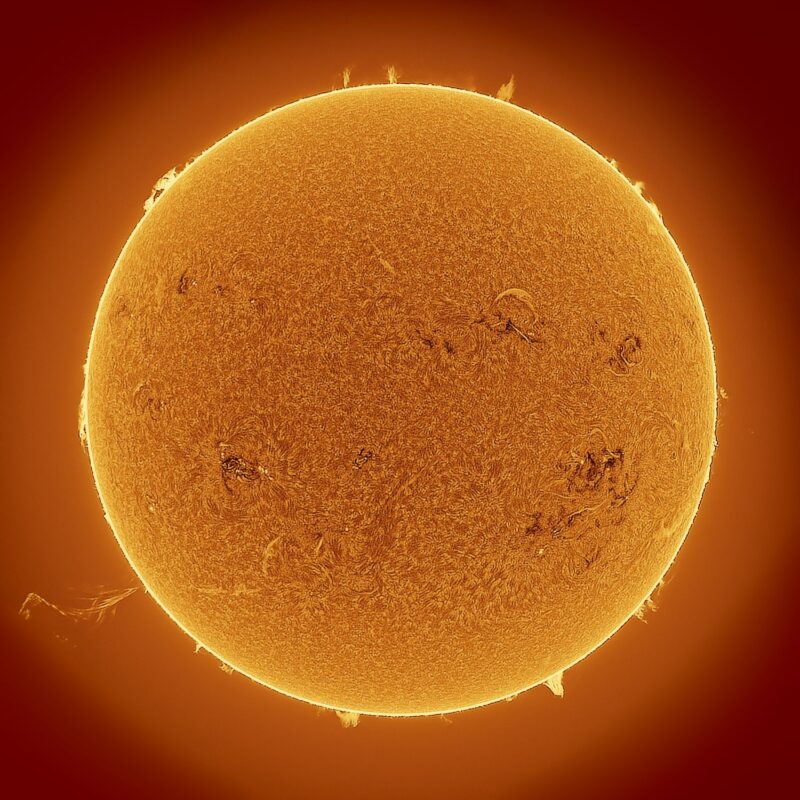
- The sun is at the peak of Solar Cycle 25. We’re at solar maximum, when the sun has the most sunspots, flares and coronal mass ejections. You might also say that we’re “halfway through” Solar Cycle 25.
- Yet researchers announced this week they already see Solar Cycle 26 beginning. Using helioseismology – a study of the sun via its oscillations (mostly caused by sound waves driven by convection near the sun’s surface) – the researchers can see a pattern of bands moving toward the sun’s equator along with the sunspots. These bands what they’ve seen at the beginning of past solar cycles.
- So, these researchers say, we’re seeing the first traces of Solar Cycle 26. Meanwhile, Solar Cycle 25 rages on, with a very active sun expected in the coming several years. The sun will die down in activity later in this decade. And the new cycle won’t officially start until around 2030.
Solar physicist C. Alex Young of Goddard Spaceflight Center – part of the team that produces EarthSky’s daily sun news post – had this to say about the announcement:
So, even now as we’re now observing the greatest number of sunspots in Solar Cycle 25 so far, researchers are detecting the barest beginnings of Solar Cycle 26. It’s exciting to see this work. Extended and overlapping solar cycles were first brought to the attention of the solar community by P.R. Wilson of the University of Sydney in the late 1980s. Nowadays, one can use the technique of helioseismology – the study of what are, essentially, sound waves inside the sun – to begin to get to the physics.
And, thanks to NASA’s SOHO and SDO sun-observing spacecraft, we are currently amassing the necessary data to observe and understand our billion-year-old star’s short-but-critical 11- and 22-year cycles.
Below is the announcement of the start of Solar Cycle 26, observed via helioseismology, from the Royal Astronomical Society on July 18, 2024. Edits by EarthSky.
The next solar cycle is already beginning
Scientists have detected the first rumblings of the sun’s next 11-year solar cycle in sound waves inside our home star … even though it is only halfway through its current one.
This existing cycle is now at its peak, or solar maximum. Solar maximum is when the sun’s magnetic field flips and its poles swap places. This solar max will continue until mid-2025.
Solar max affects activity on the sun’s surface. Sunspots, flares and coronal mass ejections are all more rampant at solar maximum. This leads to a surge in electromagnetic energy hurtling toward Earth, making auroras visible more often and at lower altitudes.
The current solar cycle – Cycle 25 – started in 2019. It has the name Cycle 25 because it’s the 25th since 1755, when extensive recording of solar sunspot activity began.
Spotting the beginnings of Cycle 26
It is not expected to end for another six years, but researchers have spotted the first signs that the next solar cycle is beginning. Researchers from the University of Birmingham presented their findings at the Royal Astronomical Society’s National Astronomy Meeting in Hull on July 18, 2024.
Astronomers use the sun’s internal sound waves to measure how it rotates, making visible a pattern of bands (solar torsional oscillation) that rotate slightly faster or slower. These move toward the sun’s equator and its poles during the activity cycle.
The faster-rotation belts tend to show up before the next solar cycle officially begins.
Dr. Rachel Howe of the University of Birmingham and her international collaborators have discovered a faint indication that the next solar cycle is starting to show up in the data they have been analyzing from the rotation bands. Howe said:
If you go back one solar cycle – 11 years – on the plot, you can see something similar that seems to join up with the shape that we saw in 2017. It went on to be a feature of the present solar cycle, Cycle 25.
We’re likely seeing the first traces of Cycle 26, which won’t officially start until about 2030.
Using helioseismic data to see inside the sun
Astronomers have been studying solar torsional oscillation signals using helioseismic data from the Global Oscillation Network Group (GONG), the Michelson Doppler Imager (MDI) onboard the Solar and Heliospheric Observatory, and the Helioseismic and Magnetic Imager (HMI) on board the Solar Dynamics Observatory since 1995.
The data now covers the first four years of Solar Cycles 23, 24 and 25. This allows researchers to compare the rising phases of these cycles.
Howe has been following the changes in the sun’s rotation for about 25 years, when scientists only had a portion of data from Solar Cycle 23 from GONG and MDI.
They could see the pattern of faster-moving material drifting toward the equator along with the sunspots. Since then, they have watched the pattern repeat (but not exactly) as Cycle 24 came and went and again as Cycle 25 grew. Howe said:
It’s exciting to see the first hint that the pattern will repeat again in Cycle 26, which is due to start in about six years.
With more data, I hope we can understand more about the part these flows play in the intricate dance of plasma and magnetic fields that form the solar cycle.
Bottom line: Astronomers using helioseismology have peered into the sun to see a pattern indicating the next solar cycle – Solar Cycle 26 – is already beginning.











